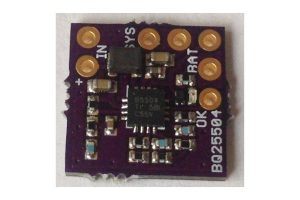What is it?
This is a small (0.5 x 0.5 inch) breakout board for Texas Instrument’s BQ25504 Ultra Low Power Boost Converter with Battery Management for Energy Harvesting Applications.
From the datasheet: “The bq25504 device is the first of a new family of intelligent integrated energy harvesting nano-power management solutions that are well suited for meeting the special needs of ultra low power applications. The device is specifically designed to efficiently acquire and manage the microwatts (µW) to milliwatts (mW) of power generated from a variety of DC sources like photovoltaic (solar) or thermal electric generators. The bq25504 is the first device of its kind to implement a highly efficient boost converter/charger targeted toward products and systems, such as wireless sensor networks (WSNs) which have stringent power and operational demands. The design of the bq25504 starts with a DC-DC boost converter/charger that requires only microwatts of power to begin operating.”
The BQ25504 is a high-efficiency boost converter of great flexibility that can be used to charge a battery using energy harvesting from a variety of sources. Here I have chosen to set the parameters of the boost converter to charge a standard one-cell, 4.2 V LiPo battery like this one. The BQ25504 employs a Maximum Power Point Tracking (MPPT) method which regulates the input impedance of the charger to maintain maximum efficiency of the solar cell. I have set the MPPT to 78% of the open-circuit voltage of the solar cell.
The BQ25504 protects the LiPo battery from undervoltage, which can cause damage through excessive discharge, as well as overvoltage to prevent excessive charging. The over- and under-voltage protection thresholds are set by a resistor network which I have chosen to limit discharging to 3.27 V and over charging to 4.27 V.
There is a battery OK threshold of 3.58 V and a battery hysteresis threshold of 3.78 V. The battery OK pin will toggle to LOW when the battery voltage falls below 3.58 V. The battery OK pin will toggle to HIGH when the battery voltage rises above 3.78 V. In other words, on decreasing battery voltage (due to discharging) the interrupt will fall and stay LOW (and the on-board green led will go out) below 3.58 V, and on increasing battery voltage (due to charging) the interrupt will rise and stay HIGH (and the green led will remain on) above 3.78 V. The battery OK pin allows an MCU to monitor the state of the battery charge. The idea is that the MCU can detect when the battery OK pin falls to the LOW logical condition (a sort of interrupt) and limit large loads until the solar cell is able to recharge the battery to a sufficient level to support the large current draw.
Read more: BQ25504 Solar Cell LiPo Charger

